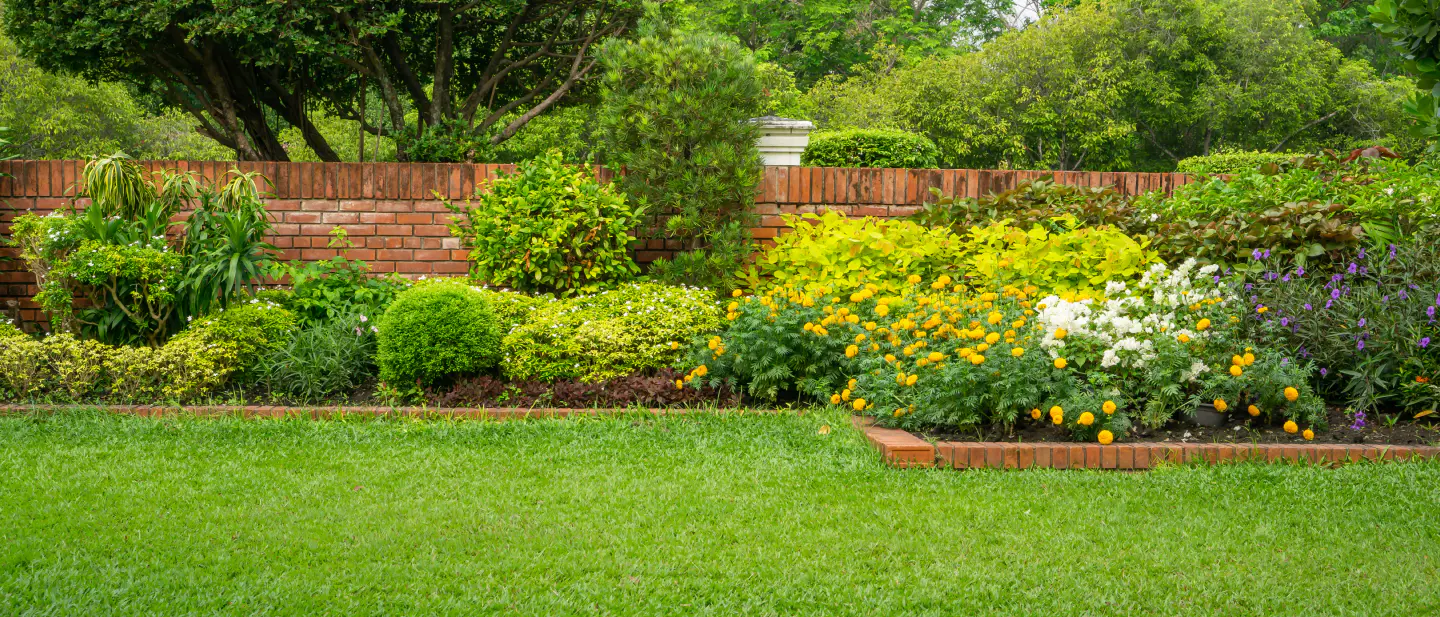
Landscape Design
What is the landscape design process?*
Our landscape design process starts with a face to face meeting on-site. This is where we learn what it is you want out of your landscape. Every client’s needs are different and we take the time to learn exactly what you want out of your property. From here we start a series of email conversations or return visits to put together a comprehensive plan based on the site characteristics and the individual goals you may have.
How do I design my backyard landscape?
To design your backyard landscape, start by assessing your space, identifying your needs, sketching your ideas, choosing plants and features that suit your climate and soil, and planning for growth and maintenance. A professional consultation can save time and help avoid costly mistakes.
What are some popular landscaping ideas?
Popular landscaping ideas include year round bloom gardens, native plant gardens, xeriscaping (low-water landscaping), edible gardens, outdoor living spaces, and water features.
What are the essential elements of landscape design?
Essential elements of landscape design are line, form, color, texture, and scale. These elements should be considered in relation to the principles of design: balance, proportion, rhythm, emphasis, and unity.
How do I choose plants for my landscape?
Choose plants for your landscape based on the conditions of your site (soil, light, climate), the style of your landscape, and your personal preferences. Consider factors like size, color, and maintenance needs.
What are some low-maintenance landscaping options?
Low-maintenance landscaping options include native plants, drought-tolerant plants, mulch, and hardscaping.
What are the current landscaping trends?
Current landscaping trends include sustainable and eco-friendly designs, outdoor living spaces, native plants, and edible gardening.
How do I create a sustainable landscape design?
To create a sustainable landscape design, use native and drought-tolerant plants, incorporate permeable paving, reduce lawn space, use efficient irrigation, and compost yard waste.
What are some common mistakes to avoid in landscape design?
Common mistakes in landscape design include neglecting to plan, choosing the wrong plants for conditions, planting too many plants in too small an area, ignoring maintenance, and failing to consider all seasons.
How much does professional landscape design cost?
The cost of professional landscape design can vary widely, from a few hundred to several thousand dollars, depending on the size and complexity of the project.
Irrigation
How does lawn irrigation work?
Lawn irrigation works by delivering water to your lawn through a system of pipes, valves, and sprinklers, either manually or automatically.
What is the best time to water my lawn?
The best time to water your lawn is early in the morning, when temperatures are cooler and winds are calmer.
How often should I water my lawn?
How often you should water your lawn depends on your soil type, grass type, and location. Even within the Tri-County area watering strategies can vary wildly based on your specific micro-climate. However in general, watering deeply 1-2 times per week is recommended.
What is the recommended amount of water for my lawn?
The recommended amount of water for your lawn is typically 1-1.5 inches per week, including rainfall.
What are the different types of lawn irrigation systems?
Different types of lawn irrigation systems include sprinkler systems, drip irrigation, soaker hoses, and rotor systems.
How do I install a sprinkler system for my lawn?
To install a sprinkler system for your lawn, you’ll need to plan your layout, have the utilities marked, dig trenches for your pipes, install the pipes and sprinkler heads, and connect to your water source. Note that in general this is a very destructive process. It will take at least 1 growing season for a healthy lawn to cover the trenches, or install new sod to cover them right away.
How do I adjust sprinkler heads for proper coverage?
Adjust sprinkler heads by turning the adjustment screw on the top of the sprinkler, or by rotating the sprinkler body. Different heads have different methods.
What are some common issues with lawn irrigation systems and how can I troubleshoot them?
Common issues with lawn irrigation systems include leaky valves, clogged nozzles, zones not working, and uneven coverage. Troubleshooting often involves checking for leaks, check wiring, cleaning or replacing parts, and adjusting sprinkler heads.
What are the benefits of using smart irrigation technology?
Benefits of using smart irrigation technology include water conservation, cost savings, and improved plant health.
How can I conserve water while irrigating my lawn?
To conserve water while irrigating your lawn, water deeply but infrequently, water in the early morning, and use efficient irrigation methods like drip irrigation or smart sprinklers.
Drainage
How do I improve drainage in my lawn/yard/garden?
To improve drainage in your lawn, you can add organic matter, install a drainage system, or create a rain garden.
What causes poor drainage in lawns/yards/gardens?
Poor drainage in lawns can be caused by compacted soil, clay soil, a high water table, or poor grading.
How can I identify if my lawn/yard/garden has drainage issues?
Signs of drainage issues in your lawn include standing water, waterlogged soil, and unhealthy plants.
What are the signs of poor drainage in a lawn/yard/garden?
Signs of poor drainage in your lawn include standing water, waterlogged soil, and unhealthy plants.
What are the different methods for installing a drainage system in a lawn/yard/garden?
Different methods for installing a drainage system in a lawn include drain box and underground pipe, French drains, dry wells, and grading.
How do I create a French drain for lawn/yard/garden drainage?
A French drain is created by digging a trench, filling it with gravel, and installing a perforated pipe that redirects water away from your lawn. This is often a last resort.
What are some natural ways to improve drainage in lawns/yards/gardens?
Natural ways to improve drainage in lawns include adding organic matter to your soil, planting water-loving plants, and creating a rain garden.
How can I prevent waterlogging in my lawn/yard/garden?
To prevent waterlogging in your lawn, improve your soil structure, avoid overwatering, and ensure your lawn is properly graded.
What are the benefits of installing a sump pump for lawn/yard/garden drainage?
Benefits of installing a sump pump for lawn drainage include preventing water damage to your home and maintaining a healthier lawn. This is another last resort option.
How do I maintain a lawn/yard/garden drainage system?
Maintain a lawn drainage system by regularly checking for blockages, cleaning out leaves and debris, and repairing any damage promptly.
Lighting
What are the benefits of landscape lighting?
The benefits of landscape lighting include enhancing the beauty of your outdoor space, improving safety and security, extending the use of your outdoor areas into the evening, and increasing property value.
How do I choose the right type of landscape lighting for my outdoor space?
To choose the right type of landscape lighting for your outdoor space, consider your needs (safety, security, aesthetics), the features you want to highlight, and the style of your home and landscape.
What are the different types of landscape lighting fixtures available?
Different types of landscape lighting fixtures include path lights, spotlights, floodlights, well lights, and deck lights.
How do I install landscape lighting in my yard or garden?
To install landscape lighting, plan your layout, choose your fixtures, install a transformer run cable to each fixture, and connect the lights.
What are some popular landscape lighting ideas and designs?
Popular landscape lighting ideas and designs include uplighting trees, backlighting for silhouettes, path lighting for safety, and using a mix of lighting types for interest and functionality.
What are the best practices for maintaining landscape lighting?
Best practices for maintaining landscape lighting include cleaning fixtures, replacing burned-out bulbs, checking for and repairing any damage, and adjusting for changes in your landscape.
How do I calculate the number of lights needed for my landscape?
To calculate the number of lights needed for your landscape, consider the size of your space, the features you want to highlight, and the type of lighting effect you want to create.
What are some energy-efficient options for landscape lighting?
Energy-efficient options for landscape lighting include LED lights and timers or sensors to reduce unnecessary lighting.
How do I troubleshoot common issues with landscape lighting?
Troubleshoot common issues with landscape lighting by checking for and replacing burned-out bulbs, checking connections and wiring, and ensuring your transformer and timer is working properly.
Are there any safety considerations for landscape lighting?
Safety considerations for landscape lighting include using low-voltage systems to reduce the risk of electrical shock, properly installing and maintaining your system to prevent fire hazards, and using lighting to improve safety by illuminating paths and potential hazards.



